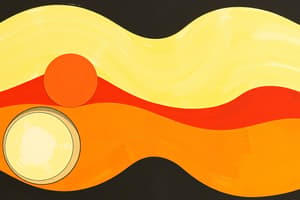Podcast
Questions and Answers
What is the primary reason for applying shading in drawing?
What is the primary reason for applying shading in drawing?
- To make drawings look flat
- To create shapes and forms in design
- To prevent the drawing from having tone
- To emphasize the important parts of a subject or display texture (correct)
What is the term for the lightness and darkness of tone in a drawing?
What is the term for the lightness and darkness of tone in a drawing?
- Texture
- Form
- Shape
- Value (correct)
What technique involves moving the pencil from left to right or top to bottom?
What technique involves moving the pencil from left to right or top to bottom?
- Regular Shading or Hatching (correct)
- Circular Shading
- Directional Shading
- Irregular Shading or Crosshatching
What is the purpose of smooching or smudging in drawing?
What is the purpose of smooching or smudging in drawing?
What is the term for shading with two directions that do not overlap?
What is the term for shading with two directions that do not overlap?
Study Notes
Shading in Drawing
- Shading enhances realism in drawings by simulating light and shadow.
- It adds depth and dimension, bringing a two-dimensional surface to life.
Lightness and Darkness in Tone
- The term used to describe the varying degrees of lightness and darkness in a drawing is "value."
- Value is crucial for creating contrast and defining forms.
Pencil Techniques
- The technique involving horizontal or vertical movements of the pencil is known as "hatching."
- Hatching can create texture and define shapes through parallel lines.
Smudging in Drawing
- "Smooching" or smudging helps to blend tones and soften lines.
- This technique can produce a more polished and cohesive appearance in the artwork.
Non-overlapping Shading Technique
- The term for shading with two directions that do not overlap is "cross-hatching."
- Cross-hatching uses intersecting lines to create rich texture and depth in shading.
Studying That Suits You
Use AI to generate personalized quizzes and flashcards to suit your learning preferences.
Description
Test your knowledge of various shading techniques used in art, including regular and irregular shading, crosshatching, circular shading, directional shading, and smooching. Learn how to create depth and dimension in your drawings with these essential skills.




